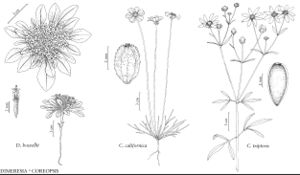Difference between revisions of "Dimeresia howellii"
in A. Gray et al., Syn. Fl. N. Amer. ed. 2, 1(2): 449. 1886.
IllustratedEndemic
Treatment appears in FNA Volume 21. Treatment on page 183.
FNA>Volume Importer |
imported>Volume Importer |
||
| (One intermediate revision by the same user not shown) | |||
| Line 1: | Line 1: | ||
{{Treatment/ID | {{Treatment/ID | ||
|accepted_name=Dimeresia howellii | |accepted_name=Dimeresia howellii | ||
| − | |accepted_authority=A. Gray | + | |accepted_authority=A. Gray |
|publications={{Treatment/Publication | |publications={{Treatment/Publication | ||
|title=in A. Gray et al., Syn. Fl. N. Amer. ed. | |title=in A. Gray et al., Syn. Fl. N. Amer. ed. | ||
|place=2, 1(2): 449. 1886 | |place=2, 1(2): 449. 1886 | ||
|year=1886 | |year=1886 | ||
| + | }} | ||
| + | |special_status={{Treatment/ID/Special_status | ||
| + | |code=F | ||
| + | |label=Illustrated | ||
| + | }}{{Treatment/ID/Special_status | ||
| + | |code=E | ||
| + | |label=Endemic | ||
}} | }} | ||
|basionyms= | |basionyms= | ||
| Line 31: | Line 38: | ||
-->{{#Taxon: | -->{{#Taxon: | ||
name=Dimeresia howellii | name=Dimeresia howellii | ||
| − | |authority=A. Gray | + | |authority=A. Gray |
|rank=species | |rank=species | ||
|parent rank=genus | |parent rank=genus | ||
| Line 44: | Line 51: | ||
|publication title=in A. Gray et al., Syn. Fl. N. Amer. ed. | |publication title=in A. Gray et al., Syn. Fl. N. Amer. ed. | ||
|publication year=1886 | |publication year=1886 | ||
| − | |special status= | + | |special status=Illustrated;Endemic |
| − | |source xml=https:// | + | |source xml=https://bitbucket.org/aafc-mbb/fna-data-curation/src/2e0870ddd59836b60bcf96646a41e87ea5a5943a/coarse_grained_fna_xml/V19-20-21/V21_449.xml |
|tribe=Asteraceae tribe Heliantheae | |tribe=Asteraceae tribe Heliantheae | ||
|subtribe=Asteraceae (tribe Heliantheae) subtribe Dimeresiinae | |subtribe=Asteraceae (tribe Heliantheae) subtribe Dimeresiinae | ||
Latest revision as of 21:12, 5 November 2020
Leaf blades (2–)10–30+ mm, initially cobwebby, glabrescent, often gland-dotted. Corollas 5–6 mm. Cypselae 2–3 mm; pappi 3–4 mm (bristles falling together). 2n = 14.
Phenology: Flowering spring–summer.
Habitat: Open gravelly or sandy places, talus slopes screes, serpentine
Elevation: 1100–2900 m
Distribution

Calif., Idaho, Nev., Oreg.
Discussion
Selected References
None.
Lower Taxa
None.
